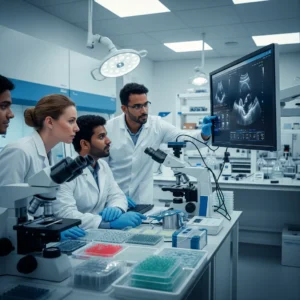Stem Cell Therapy Success Rates can vary – it all depends on things like your physical condition, specific treatment you’re looking at, quality of Stem Cells and the clinic you’re visiting.
If you’re thinking about getting Stem Cell Therapy Treatment, our article on Should I get Stem Cell Therapy might be useful. or set up a conversation with our team here. They can guide you in deciding if it’s the right fit, help you choose the best clinic & region, and even assist you in securing some great discounts!
What are the success rates for Stem Cell Therapy?
- Orthopedic Conditions (like Osteoarthritis): These tend to do really well, with success rates often around 75-85%, especially when mesenchymal stem cells (MSCs) are used.
- Anti-Aging Treatments: While the results are promising, it’s a bit harder to pin down specific success rates because these treatments are often more subjective.
- Neurological Disorders (like Autism or ALS): These are still mostly experimental. Outcomes can vary widely depending on the clinical trial or therapy being tested.
- Hematopoietic Stem Cell Transplants: For blood disorders like leukemia, success rates are c.70%, depending on factors like donor match and the patient’s overall health.
Here is more detail on the factors that will affect your success rates.
Factors influencing Stem Cell Treatment Success
Source of Stem Cells
Where the Stem Cells come from is a big deal:
- Autologous (from the patient): These reduce the risk of rejection but might not work as well if the patient is older or dealing with illness.
- Allogeneic (from a donor): These are often of higher quality but can sometimes trigger immune responses.
- Stem Cell Type: Different stem cells do different jobs. MSCs are great for orthopedic injuries, while hematopoietic stem cells shine in treating blood disorders.
Quality of Stem Cells
Not all Stem Cells are created equal. High-quality cells are more likely to do what they’re supposed to—whether that’s healing cartilage or repairing tissues. And let’s be honest, nobody wants “low-quality” anything when it comes to their health!
Stem Cells should come from a reputable, GMP-compliant lab that follows strict safety and quality standards. Clinics must ensure that the cells are regularly tested for viability, purity, and potency before use. This not only guarantees their effectiveness but also minimizes risks to patients.
Immune System Rejection
If the body sees the Stem Cells as foreign invaders, it may fight back. This is less of an issue with autologous cells, but donor cells can require a lot of careful matching to avoid problems.
Researchers are actively exploring ways to reduce the risk of immune rejection. For instance, a recent review of clinical trials found that short-term use of immunosuppressive therapies significantly lowered the chances of immune rejection in retinal stem cell treatments. This highlights the importance of tailored approaches to support cell survival in different conditions.
Clinic Quality
Would you trust your treatment to just any clinic? The expertise of the medical team and the standards of the facility matter. Top-notch clinics use Good Manufacturing Practices (GMP) and have experienced professionals running the show.
Specific Treatment Goals
The type of condition being treated plays a huge role in success. Tendon injuries or osteoarthritis tend to respond well, while more complex issues like spinal injuries might have more mixed results.
Patient’s Physical Condition
Your body’s overall health can make or break the outcome. Younger patients or those in good health generally see better results. Pre-existing conditions? Those can sometimes complicate things.
Administration Method
How the Stem Cells are delivered—whether by injection, IV, or surgery—matters. The right method depends on the condition being treated and the location of the damage.
Pre- and Post-Treatment Care
The best clinics don’t just send you on your way after treatment. Proper preparation and recovery plans, like physical therapy, can make a huge difference in how well Stem Cell Therapy works.
Stem Cell Dosage
Sometimes more is better, but only up to a point. Clinics need to calculate the right dose to ensure effectiveness without unnecessary risks.
Patient Lifestyle
Smoking, poor diet, and alcohol can seriously sabotage your results. Living a healthy lifestyle can give your body the boost it needs to heal.
While these factors can influence the success of Stem Cell Therapy, it’s also important to consider the broader challenges facing this field. Success rates aren’t always straightforward, and there are limitations that patients should keep in mind before pursuing treatment.
Limitations of Stem Cell Therapy
Stem Cell Therapy holds a lot of promise, but let’s be real—it’s not a guaranteed fix. There are challenges that can affect success rates, and it’s important to understand them so you know what to expect. Here’s a closer look:
Lack of Standardization
Stem Cell Therapy is still evolving, and there’s no one-size-fits-all approach yet. This leads to:
- Stem Cell Preparation: Clinics use different methods for isolating and administering stem cells, which means results can vary.
- Cell Types Used: Some clinics use mesenchymal stem cells (MSCs), while others might use hematopoietic or induced pluripotent stem cells (iPSCs), creating inconsistent outcomes.
- Dosage: There’s no universal “ideal dose,” so figuring out how much is enough—but not too much—is still a work in progress.
Novelty of Stem Cell Therapy
Let’s not forget that Stem Cell Therapy is still relatively new. There are some big questions that remain unanswered:
- Long-Term Outcomes: Short-term results can be promising, but we don’t have decades of data to know how well it holds up over time.
- Regulatory Oversight: Some countries have strict guidelines, while others allow experimental treatments with little oversight.
- Mechanisms of Action: Scientists are still figuring out exactly how stem cells work for complex conditions like neurological disorders or autoimmune diseases.
Ethical and Safety Concerns
With new treatments come risks—both ethical and physical. Some clinics take advantage of the hype around stem cell therapy and offer treatments that aren’t backed by science. These can be ineffective—or even harmful.
Why This Matters
Acknowledging these limitations doesn’t take away from the potential of stem cell therapy—it just sets the stage for realistic expectations. The key is choosing a clinic that values safety and science over shortcuts. Look for one that follows Good Manufacturing Practices (GMP) and offers transparent, research-backed treatments.
By understanding these challenges, you’ll be in a much better position to make informed decisions and get the most out of your treatment.
Conclusion
Stem Cell Therapy offers life-changing potential, but no good clinic guarantees success or promises results. From immune rejection to lack of follow-up care, unproven efficacy, and profit-driven motives—many factors can influence the success rate.
The quality of the clinic you choose is one of the most important factors, and that’s where we come in, connecting you to pre-vetted clinics that actually follow strict regulations and processes, reach out to us here for help!
If you want to learn more about the actual treatment process, this article might be useful!
We provide you with unbiased information helping you learn about Stem Cell Therapy & see if it’s right for you. Our platform can also connect you with the best clinics in the right areas & get you some cool discounts! Fill out our form here to learn more. ( Our Find a clinic page is coming soon!)
Specific conditions, the type of therapy, clinic quality, and individual patient factors determine the cost-effectiveness of stem cell therapy. For some, it may provide significant benefits, while for others, the high costs may not justify the outcomes.
Short Terms risks from good quality clinics aren’t high risk and now that people aren’t using Embryonic Cells, tumor development isn’t a concern in the short term. However, if you’re getting treatment from a shady clinic who aren’t testing their cells and could be putting anything into your body, risks can be quite high.
However, in the long term we just don’t have the data to understand what long term risks there are 10, 20 years down the line. We go into the side effects of Stem Cell Therapy here.
The duration of effectiveness varies widely. Some patients experience relief for months or years, while others may see limited benefits. Factors influencing effectiveness include the condition treated, the type of stem cells used, and individual patient responses. Ongoing research continues to explore the long terms results for Stem Cell Therapy
Fill in your details below
For a discounted offer for Stem Cell Therapy!













